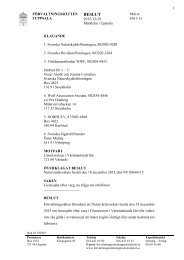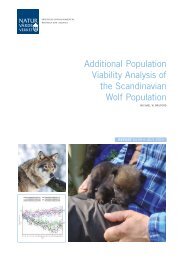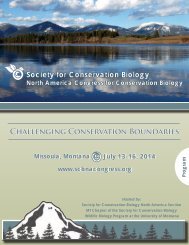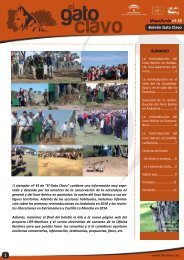1oC3Dbk
1oC3Dbk
1oC3Dbk
You also want an ePaper? Increase the reach of your titles
YUMPU automatically turns print PDFs into web optimized ePapers that Google loves.
Témpore Secretariat by providing technical information and<br />
concerns with regards to pacovicuña breeding in USA. In<br />
November, we participated at the First Board Meeting of the<br />
Vicuña Managing Communities Association and provided<br />
advice. At the national level, several of our members<br />
participated in the first and second workshop to develop a<br />
national census for the guanaco in Argentina, and we took part<br />
in the Preparatory Worksop for the development of a Vicuña<br />
Management Plan. Several of our members were involved in<br />
the development of sustainable use initiatives for vicuñas and<br />
guanacos. At present, we are assessing a law proposal that<br />
wants to put the management of guanaco on the same basis<br />
as sheep in Argentinean Patagonia.<br />
Red List Authority members started working on the<br />
reassessment of vicuñas and guanacos at the species level<br />
which will be finished in April 2014. This assessment will be<br />
followed by an assessment at the subspecies level, to be<br />
undertaken during 2014. We have developed new quantitative<br />
guidelines for the admission of new group members; the new<br />
assessments will be based on research and academic<br />
experience on South American wild camelids, dissemination<br />
activities, articulation with the public sector, priority areas, and<br />
present engagement with camelid research. In our visit to<br />
Ecuador, IUCN-Sur filmed an interview where we promoted the<br />
work of our group and discussed the conservation challenges<br />
for vicuñas and guanacos.<br />
We would like to thank the Copenhagen Zoo for their<br />
support, which enabled us to attend the Vicuña Convention.<br />
Dr Gabriela Lichtenstein<br />
Chair, South American Camelid Specialist Group<br />
South Asian Invertebrate Specialist Group<br />
The objective of the South Asian Invertebrate Specialist Group<br />
Vicuñas en los Andes. © Dr Gabriela Lichtenstein<br />
(SAsISG) is to influence, encourage, and assist societies in<br />
South Asia (Afghanistan, Bangladesh, Bhutan, India, Maldives,<br />
Nepal, Pakistan and Sri Lanka) to conserve invertebrate<br />
diversity; to achieve it through knowledge, empowerment,<br />
governance and operations.<br />
We collated and created baseline information on butterflies<br />
of South Asia; for 750 species of butterflies from six families.<br />
The objective of the project is to assess and to develop a<br />
conservation action plan for this region. We initiated a project<br />
to collate species information on millipedes of India, for<br />
species assessment at a later date. We conducted an<br />
invertebrate pollinator conservation training and education<br />
workshop in India, in collaboration with international and local<br />
partners. This exercise will be repeated to cover the rest of the<br />
region. We designed and published educational materials on<br />
invertebrate pollinator conservation. Recommendations of the<br />
Western Ghats freshwater biodiversity assessment report were<br />
implemented, and wide awareness was created through<br />
training and outreach.<br />
We greatly acknowledge the following donors for their<br />
generous support – Zoological Society of London, Mohamed<br />
bin Zyed Conservation Fund, Chester Zoo, Xerces Society,<br />
Columbus Zoo and the Critical Ecosystem Partnership Fund.<br />
Dr Bexell Ayyachamy Daniel and Dr Muhammad<br />
Ather Rafi<br />
Co-chairs, South Asian Invertebrate Specialist Group<br />
Southern African Plant Specialist Group<br />
The Southern African Plant Specialist Group (SAPSG) consists<br />
of 20 botanists working in Southern African countries (South<br />
Africa, Lesotho, Swaziland, Mozambique, Zimbabwe,<br />
Botswana and Namibia). The main aim of this group is to<br />
conduct conservation assessments of plant species endemic<br />
to the region, and to ensure the effective monitoring and<br />
conservation of plant species of conservation concern.<br />
During 2013, extensive work on surveying the woody flora<br />
of northern Mozambique was undertaken by members of the<br />
SAPSG. This area has been found to contain high numbers of<br />
endemic woody species (85) and it also shares many<br />
restricted range species with the Lindi region of southern<br />
Tanzania. As a result of this work, a new centre of endemism<br />
shared between northern Mozambique and southern Tanzania<br />
called the Rovuma centre will be published. The rich forests of<br />
Pill millipede, Agumbe rainforest, Karnataka. © Blnu Priya<br />
84 IUCN species Annual Report 2013






